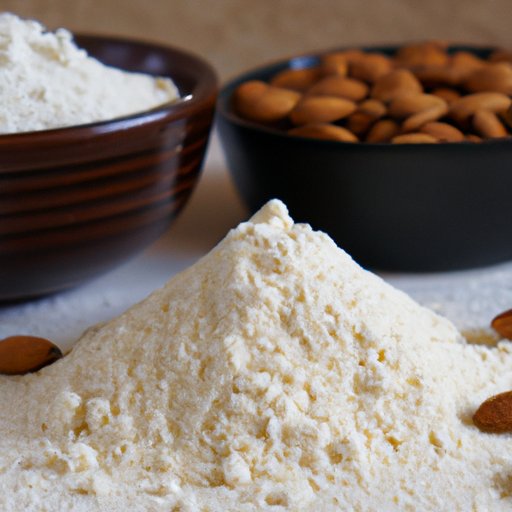
Introduction
Are you looking to make healthier choices in your baking, but aren’t sure if almond flour is a good substitute for regular flour? Almond flour is becoming increasingly popular due to its many health benefits and delicious taste. In this article, we’ll explore the differences between almond flour and regular flour, the benefits of using almond flour, and provide a beginner’s guide to substituting almond flour in your favorite recipes.
Almond Flour vs. Regular Flour: What’s the Difference?
Almond flour is made by grinding blanched almonds into a fine powder. It has a grainy and slightly moist texture compared to regular flour, which is made by grinding wheat grains. Almond flour is also higher in protein, healthy fats, and lower in carbohydrates than regular flour. In terms of taste, almond flour has a nutty and sweet flavor, while regular flour has a neutral taste.
The Benefits of Using Almond Flour Instead of Regular Flour
One of the biggest benefits of using almond flour is its low glycemic index, which means it doesn’t spike your blood sugar levels like regular flour does. Almond flour is also gluten-free, making it an excellent choice for those with gluten sensitivities or celiac disease. Additionally, almond flour is high in protein, healthy fats, and essential nutrients such as vitamin E and magnesium. When used in baked goods, almond flour creates a soft and moist texture, which enhances the taste and quality of the final product. Finally, almond flour is a popular ingredient in many diets including vegan, paleo, low-carb, and keto.
A Beginner’s Guide to Substituting Almond Flour for Regular Flour
Substituting almond flour for regular flour can be a bit tricky, but it’s not impossible. The key is to find the right ratio for the recipe you’re using. The general rule of thumb is to use a 1:1 ratio of almond flour to regular flour. However, some recipes may require more or less almond flour depending on the desired texture and taste. When using almond flour, it’s also important to adjust other recipe ingredients, such as eggs and liquid, to ensure that the recipe turns out well. Common mistakes to avoid when using almond flour include overmixing the batter and not greasing the baking pan enough.
5 Tips for Successful Baking with Almond Flour
To ensure that your baked goods using almond flour turn out well, keep the following five tips in mind:
- Use room temperature ingredients to help the batter better incorporate the almond flour.
- Preheat the oven to the correct temperature to ensure even baking.
- Use a fine, blanched almond flour for best results.
- Mix the almond flour with other flours or ingredients to prevent a gritty texture.
- Keep an eye on the baking time, as baking with almond flour often requires less time than regular flour.
Recipes That Work Best with Almond Flour Instead of Regular Flour
Almond flour works well in many baking recipes, but it’s particularly suited for recipes that require a soft, moist texture such as cakes, muffins, and cookies. For example, almond flour pancakes are a delicious and easy breakfast option, and almond flour pizza crust makes a tasty and healthier alternative to regular pizza dough. The unique benefits of using almond flour in these recipes include improved texture and taste, increased protein and healthy fat content, and gluten-free properties. Depending on personal preferences and dietary needs, these recipes can be easily modified with different flavorings or toppings.
DIY Almond Flour: How to Make Your Own from Scratch
If you prefer to make your own almond flour from scratch, it’s easy to do. All you need is blanched almonds, a food processor, and a sifter. Simply grind the almonds in the food processor until they’re finely ground, then sift out any larger pieces. Homemade almond flour is less expensive than store-bought and can be made in small or large batches. However, keep in mind that making your own almond flour can be time-consuming and may not be as fine as store-bought flour.
The Pros and Cons of Substituting Almond Flour for Regular Flour in Your Favorite Recipes
Overall, substituting almond flour for regular flour has many benefits. It’s a great option for those looking to make healthier choices in their baking, and it works well in many recipes. However, there are some disadvantages to using almond flour that should be considered. Almond flour is more expensive than regular flour, and it can be difficult to find in some stores. Additionally, almond flour has a nutty flavor, which may not be desired in all recipes. Finally, almond flour is not a 1:1 substitute for regular flour, so some trial and error may be needed when substituting.
Conclusion
Substituting almond flour for regular flour can be a healthy and tasty choice in your baking. By following the tips and guidelines listed in this article, you can successfully replace regular flour with almond flour in many recipes. Whether you’re looking to make almond flour pancakes or a gluten-free cake, almond flour can add a lot to your baking.




